1
2
3
4
5
6
7
8
9
10
11
12
13
14
15
16
17
18
19
20
21
22
23
24
25
26
27
28
29
30
31
32
33
34
35
36
37
38
39
40
41
42
43
44
45
46
47
48
49
50
51
52
53
54
55
56
57
58
59
60
61
62
63
64
65
66
67
68
69
70
71
72
73
74
75
76
77
78
79
80
81
82
83
84
85
86
87
88
89
90
91
92
93
94
95
96
97
98
99
100
101
102
103
104
105
106
107
108
109
110
111
112
113
114
115
116
117
118
119
120
121
122
123
124
125
126
127
128
129
130
131
132
133
134
135
136
137
138
139
140
141
142
143
144
145
146
147
148
149
150
151
152
153
154
155
156
157
158
159
160
161
162
163
164
165
166
167
168
169
170
171
172
173
174
175
176
177
178
179
180
181
182
183
184
185
186
187
188
189
190
191
192
193
194
195
196
197
198
199
200
201
202
203
204
205
206
207
208
209
210
211
212
213
214
215
216
217
218
219
220
221
222
223
224
225
226
227
228
229
230
231
232
233
234
235
236
237
238
239
240
241
242
243
244
245
246
247
248
249
250
251
252
253
254
255
256
257
258
259
260
261
262
263
264
265
266
267
268
269
270
271
272
273
274
275
276
277
278
279
280
281
282
283
284
285
286
287
288
289
290
291
292
293
294
295
296
297
298
299
300
301
302
303
304
305
306
307
308
309
310
311
312
313
314
315
316
317
318
319
320
321
322
323
324
325
326
327
328
329
330
331
332
333
334
335
336
337
338
339
340
341
342
343
344
345
346
347
348
349
350
351
352
353
354
355
356
357
358
359
360
361
362
363
364
365
366
367
368
369
370
371
372
373
374
375
376
377
378
379
380
381
382
383
384
385
386
387
388
389
390
391
392
393
394
395
396
397
398
399
400
401
402
403
404
405
406
407
408
409
410
411
412
413
414
415
416
417
418
419
420
421
422
423
424
425
426
427
428
429
430
431
432
433
434
435
436
437
438
439
440
441
442
443
444
445
446
447
448
449
450
451
|
<!--
---
title: "Netdata"
date: 2020-05-01
custom_edit_url: https://github.com/netdata/netdata/edit/master/README.md
---
-->
# Netdata [](https://travis-ci.com/netdata/netdata) [](https://bestpractices.coreinfrastructure.org/projects/2231) [](https://www.gnu.org/licenses/gpl-3.0) [](<>)
[](https://codeclimate.com/github/netdata/netdata)
[](https://www.codacy.com/app/netdata/netdata?utm_source=github.com&utm_medium=referral&utm_content=netdata/netdata&utm_campaign=Badge_Grade)
[](https://lgtm.com/projects/g/netdata/netdata/context:cpp)
[](https://lgtm.com/projects/g/netdata/netdata/context:javascript)
[](https://lgtm.com/projects/g/netdata/netdata/context:python)
---
Netdata is **distributed, real-time performance and health monitoring** for systems and applications. It is a
highly-optimized monitoring agent you install on all your systems and containers.
Netdata provides **unparalleled insights**, in **real-time**, of everything happening on the systems it's running on
(including web servers, databases, applications), using **highly interactive web dashboards**.
A highly-efficient database **stores long-term historical metrics for days, weeks, or months**, all at 1-second
granularity. Run this long-term storage autonomously, or integrate Netdata with your existing monitoring toolchains
(Prometheus, Graphite, OpenTSDB, Kafka, Grafana, and more).
Netdata is **fast** and **efficient**, designed to permanently run on all systems (**physical** and **virtual** servers,
**containers**, **IoT** devices), without disrupting their core function.
Netdata is **free, open-source software** and it currently runs on **Linux**, **FreeBSD**, and **macOS**, along with
other systems derived from them, such as **Kubernetes** and **Docker**.
Netdata is not hosted by the CNCF but is the fourth most starred open-source project in the [Cloud Native Computing
Foundation (CNCF) landscape](https://landscape.cncf.io/format=card-mode&grouping=no&sort=stars).
---
People get **addicted to Netdata**. Once you use it on your systems, **there is no going back**! _You've been warned..._

[](https://twitter.com/intent/tweet?text=Netdata,%20real-time%20performance%20and%20health%20monitoring,%20done%20right!&url=https://my-netdata.io/&via=linuxnetdata&hashtags=netdata,monitoring)
## Contents
1. [What does it look like?](#what-does-it-look-like) - Take a quick tour through the dashboard
2. [Our userbase](#user-base) - Enterprises we help monitor and our userbase
3. [Quickstart](#quickstart) - How to try it now on your systems
4. [Why Netdata](#why-netdata) - Why people love Netdata and how it compares with other solutions
5. [News](#news) - The latest news about Netdata
6. [How Netdata works](#how-it-works) - A high-level diagram of how Netdata works
7. [Infographic](#infographic) - Everything about Netdata in a single graphic
8. [Features](#features) - How you'll use Netdata on your systems
9. [Visualization](#visualization) - Learn about visual anomaly detection
10. [What Netdata monitors](#what-netdata-monitors) - See which apps/services Netdata auto-detects
11. [Documentation](#documentation) - Read the documentation
12. [Community](#community) - Discuss Netdata with others and get support
13. [License](#license) - Check Netdata's licencing
14. [Is it any good?](#is-it-any-good) - Yes.
15. [Is it awesome?](#is-it-awesome) - Yes.
## What does it look like?
The following animated GIF shows the top part of a typical Netdata dashboard.
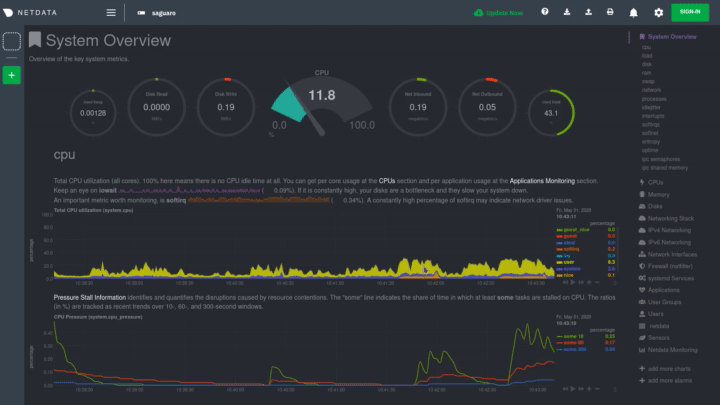
> A typical Netdata dashboard, in 1:1 timing. Charts can be panned by dragging them, zoomed in/out with `SHIFT` + `mouse
> wheel`, an area can be selected for zoom-in with `SHIFT` + `mouse selection`. Netdata is highly interactive,
> **real-time**, and optimized to get the work done!
Want to try Netdata before you install? See our [live
demo](https://london.my-netdata.io/default.html#menu_system_submenu_cpu;theme=slate;help=true).
## User base
Netdata is used by hundreds of thousands of users all over the world. Check our [GitHub watchers
list](https://github.com/netdata/netdata/watchers). You will find people working for **Amazon**, **Atos**, **Baidu**,
**Cisco Systems**, **Citrix**, **Deutsche Telekom**, **DigitalOcean**, **Elastic**, **EPAM Systems**, **Ericsson**,
**Google**, **Groupon**, **Hortonworks**, **HP**, **Huawei**, **IBM**, **Microsoft**, **NewRelic**, **Nvidia**, **Red
Hat**, **SAP**, **Selectel**, **TicketMaster**, **Vimeo**, and many more!
### Docker pulls
We provide Docker images for the most common architectures. These are statistics reported by Docker Hub:
[](https://hub.docker.com/r/netdata/netdata/)
[](https://hub.docker.com/r/firehol/netdata/)
[](https://hub.docker.com/r/titpetric/netdata/)
### Registry
When you install multiple Netdata, they are integrated into **one distributed application**, via a [Netdata
registry](/registry/README.md). This is a web browser feature and it allows us to count the number of unique users and
unique Netdata servers installed. The following information comes from the global public Netdata registry we run:
[](https://registry.my-netdata.io/#menu_netdata_submenu_registry)
[](https://registry.my-netdata.io/#menu_netdata_submenu_registry)
[](https://registry.my-netdata.io/#menu_netdata_submenu_registry)
_In the last 24 hours:_<br/> [](https://registry.my-netdata.io/#menu_netdata_submenu_registry)
[](https://registry.my-netdata.io/#menu_netdata_submenu_registry)
[](https://registry.my-netdata.io/#menu_netdata_submenu_registry)
## Quickstart


To install Netdata from source on any Linux system (physical, virtual, container, IoT, edge), including all dependencies
required to connect to Netdata Cloud, and get _automatic nightly updates_, run the following as your normal user:
```bash
# make sure you run `bash` for your shell
bash
# install Netdata directly from GitHub source
bash <(curl -Ss https://my-netdata.io/kickstart.sh)
```
Starting with v1.12, Netdata collects anonymous usage information by default and sends it to Google Analytics. Read
about the information collected, and learn how to-opt, on our [anonymous statistics](/docs/anonymous-statistics.md) page.
The usage statistics are _vital_ for us, as we use them to discover bugs and prioritize new features. We thank you for
_actively_ contributing to Netdata's future.
To learn more about the pros and cons of using _nightly_ vs. _stable_ releases, see our [notice about the two options](/packaging/installer/README.md#nightly-vs-stable-releases).
The above command will:
- Install any required packages on your system (it will ask you to confirm before doing so)
- Compile it, install it, and start it.
More installation methods and additional options can be found at the [installation
page](/packaging/installer/README.md).
To try Netdata in a Docker container, run this:
```sh
docker run -d --name=netdata \
-p 19999:19999 \
-v netdatalib:/var/lib/netdata \
-v netdatacache:/var/cache/netdata \
-v /etc/passwd:/host/etc/passwd:ro \
-v /etc/group:/host/etc/group:ro \
-v /proc:/host/proc:ro \
-v /sys:/host/sys:ro \
-v /etc/os-release:/host/etc/os-release:ro \
--restart unless-stopped \
--cap-add SYS_PTRACE \
--security-opt apparmor=unconfined \
netdata/netdata
```
For more information about running Netdata in Docker, check the [docker installation page](/packaging/docker/README.md).

From Netdata v1.12 and above, anonymous usage information is collected by default and sent to Google Analytics. To read
more about the information collected and how to opt-out, check the [anonymous statistics
page](/docs/anonymous-statistics.md).
## Why Netdata
Netdata has a quite different approach to monitoring.
Netdata is a monitoring agent you install on all your systems. It is:
- A **metrics collector** for system and application metrics (including web servers, databases, containers, and much
more),
- A **long-term metrics database** that stores recent metrics in memory and "spills" historical metrics to disk for
efficient long-term storage,
- A super fast, interactive, and modern **metrics visualizer** optimized for anomaly detection,
- And an **alarms notification engine** for detecting performance and availability issues.
All the above, are packaged together in a very flexible, extremely modular, distributed application.
This is how Netdata compares to other monitoring solutions:
| Netdata | others (open-source and commercial) |
| :-------------------------------------------------------------- | :--------------------------------------------------------------- |
| **High resolution metrics** (1s granularity) | Low resolution metrics (10s granularity at best) |
| Monitors everything, **thousands of metrics per node** | Monitor just a few metrics |
| UI is super fast, optimized for **anomaly detection** | UI is good for just an abstract view |
| **Long-term, autonomous storage** at one-second granularity | Centralized metrics in an expensive data lake at 10s granularity |
| **Meaningful presentation**, to help you understand the metrics | You have to know the metrics before you start |
| Install and get results **immediately** | Long preparation is required to get any useful results |
| Use it for **troubleshooting** performance problems | Use them to get _statistics of past performance_ |
| **Kills the console** for tracing performance issues | The console is always required for troubleshooting |
| Requires **zero dedicated resources** | Require large dedicated resources |
Netdata is **open-source**, **free**, super **fast**, very **easy**, completely **open**, extremely **efficient**,
**flexible** and integrate-able.
It has been designed by **system administrators**, **DevOps engineers**, and **developers** for to not just visualize
metrics, but also troubleshoot complex performance problems.
## News
`May 11, 2020` - **[Netdata v1.22.0 released!](https://github.com/netdata/netdata/releases)**
Release v1.22.0 marks the official launch of our rearchitected Netdata Cloud! This Agent release contains both backend and interface changes necessary to connect your distributed nodes to this dramatically improved experience.
Netdata Cloud builds on top of our open source monitoring Agent to give you real-time visibility for your entire infrastructure. Once you've connected your Agents to Cloud, you can view key metrics, insightful charts, and active alarms from all your nodes in a single web interface. When an anomaly strikes, seamlessly navigate to any node to troubleshoot and discover the root cause with the familiar Netdata dashboard.
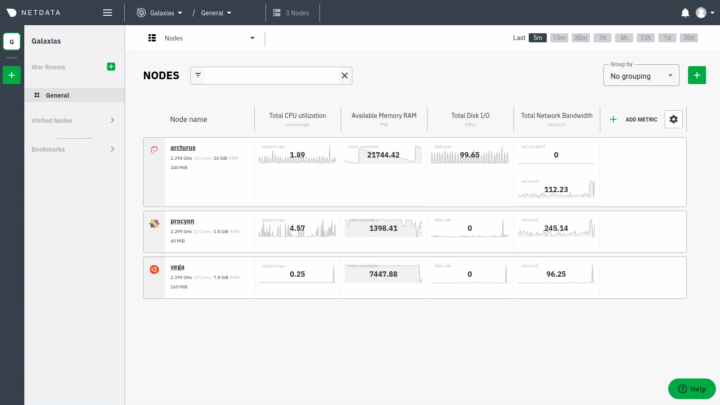
**[Sign in to Cloud](https://app.netdata.cloud)** and read our [Get started with Cloud](https://learn.netdata.cloud/docs/cloud/get-started/) guide for details on updating your nodes, claiming them, and navigating the new Cloud.
While Netdata Cloud offers a centralized method of monitoring your Agents, your metrics data is not stored or centralized in any way. Metrics data remains with your nodes and is only streamed to your browser through Cloud.
In addition, Cloud only expands on the functionality of the wildly popular free and open source Agent. We will never make any of our open source Agent features Cloud-exclusive, and we will actively continue to develop the Agent so that we can integrate new features with Netdata Cloud.
We added a new collector called `whoisquery` that helps you **monitor a domain name's expiration date**. You can track as many domains as you'd like, and set custom warning and critical thresholds for each. For more information on setup and configuration, see the [Whois domain expiry monitoring documentation](https://learn.netdata.cloud/docs/agent/collectors/go.d.plugin/modules/whoisquery/).
We added a new connector to our experimental exporting engine: **[Prometheus remote write](https://learn.netdata.cloud/docs/agent/exporting/prometheus/remote_write/)**. You can use this connector to send Netdata metrics to your choice of more than 20 external storage providers for long-term archiving and further analysis.
Our new documentation experience is now available at **[Netdata Learn](https://learn.netdata.cloud)**! We encourage you to try it out and give us feedback or ask questions in our [GitHub issues](https://github.com/netdata/netdata/issues/new/choose). Learn features documentation for both the Agent and Cloud in separate-but-connected vaults, which streamlines the experience of learning about both products.
While Learn only features documentation for now, we plan on releasing more types of educational content serving the Agent's open-source community of developers, sysadmins, and DevOps folks. We'll have more to announce soon, but in the meantime, we hope you enjoy what we believe is a smoother (and prettier) docs experience.
As part of the ongoing work to polish our **eBPF collector tech preview**, we've now proven the collector's performance is very good, and have vastly expanded the number of operating system versions the collector works on. Learn how to [enable it](https://docs.netdata.cloud/collectors/ebpf.plugin/) in our documentation. We've also extensively stress-tested the eBPF collector and found that it's impressively fast given the depth of metrics it collects! Read up on our benchmarking analysis [on GitHub](https://github.com/netdata/netdata/issues/8195).
---
See more news and previous releases at our [blog](https://blog.netdata.cloud) or our [releases
page](https://github.com/netdata/netdata/releases).
## How it works
Netdata is a highly efficient, highly modular, metrics management engine. Its lockless design makes it ideal for
concurrent operations on the metrics.
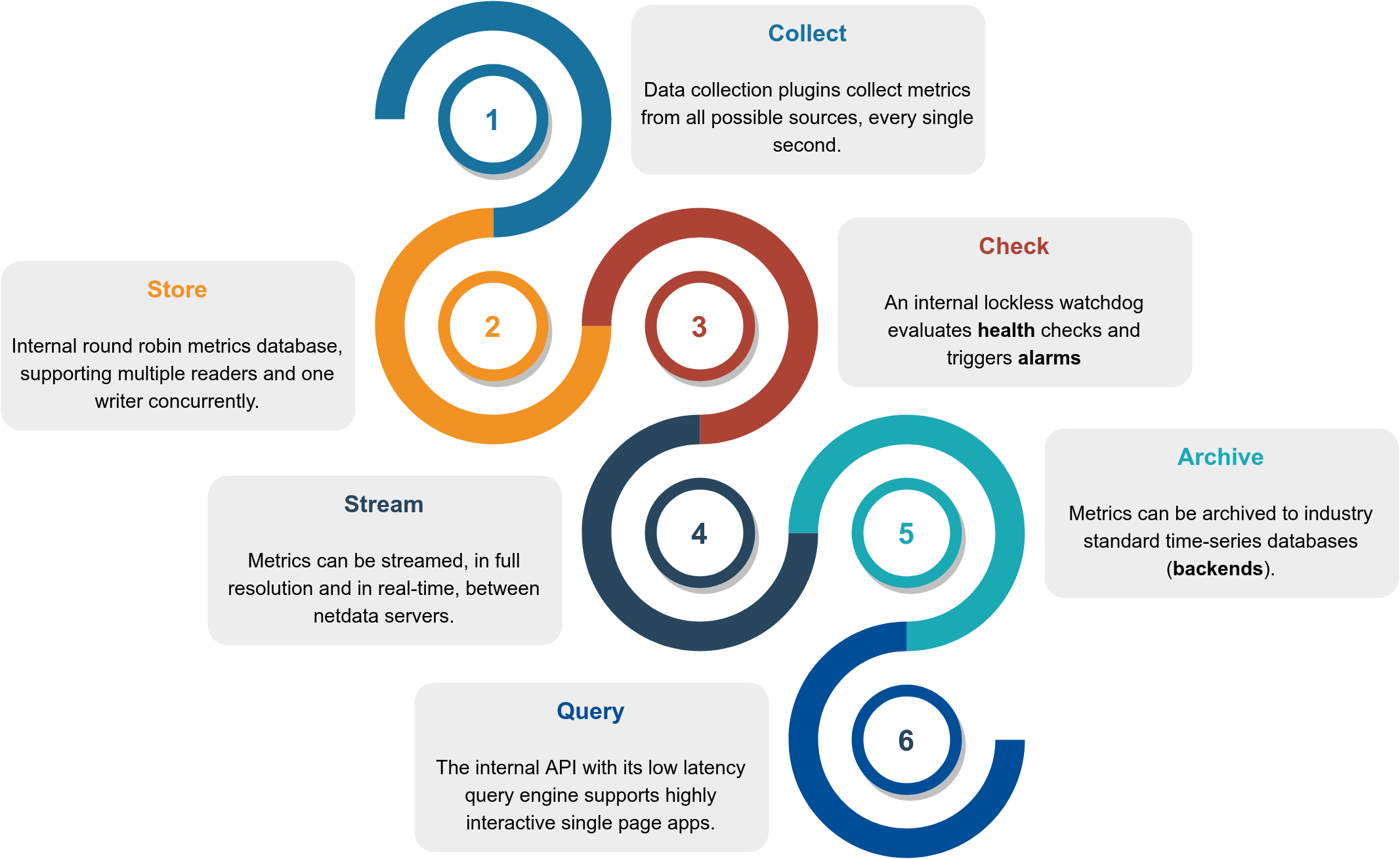
This is how it works:
| Function | Description | Documentation |
| :---------- | :------------------------------------------------------------------------------------------------------------------------------------------------------------------------------------------------------------------------------------------------------------- | :-------------------------------------------------- |
| **Collect** | Multiple independent data collection workers are collecting metrics from their sources using the optimal protocol for each application and push the metrics to the database. Each data collection worker has lockless write access to the metrics it collects. | [`collectors`](/collectors/README.md) |
| **Store** | Metrics are first stored in RAM in a custom database engine that then "spills" historical metrics to disk for efficient long-term metrics storage. | [`database`](/database/README.md) |
| **Check** | A lockless independent watchdog is evaluating **health checks** on the collected metrics, triggers alarms, maintains a health transaction log and dispatches alarm notifications. | [`health`](/health/README.md) |
| **Stream** | A lockless independent worker is streaming metrics, in full detail and in real-time, to remote Netdata servers, as soon as they are collected. | [`streaming`](/streaming/README.md) |
| **Archive** | A lockless independent worker is down-sampling the metrics and pushes them to **backend** time-series databases. | [`exporting`](/docs/export/README.md) |
| **Query** | Multiple independent workers are attached to the [internal web server](/web/server/README.md), servicing API requests, including [data queries](/web/api/queries/README.md). | [`web/api`](/web/api/README.md) |
The result is a highly efficient, low-latency system, supporting multiple readers and one writer on each metric.
## Infographic
This is a high level overview of Netdata feature set and architecture. Click it to to interact with it (it has direct
links to our documentation).
[](https://my-netdata.io/infographic.html)
## Features
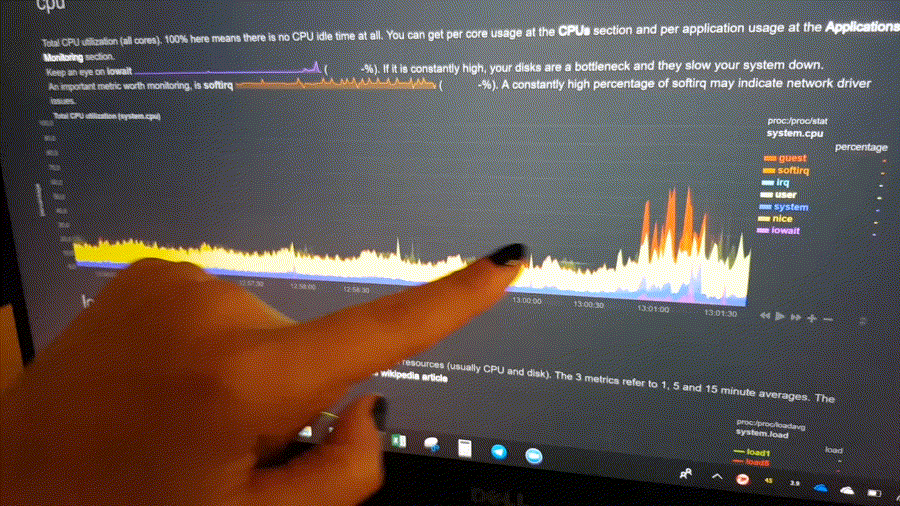
This is what you should expect from Netdata:
### General
- **1s granularity** - The highest possible resolution for all metrics.
- **Unlimited metrics** - Netdata collects all the available metrics—the more, the better.
- **1% CPU utilization of a single core** - It's unbelievably optimized.
- **A few MB of RAM** - The highly-efficient database engine stores per-second metrics in RAM and then "spills"
historical metrics to disk long-term storage.
- **Minimal disk I/O** - While running, Netdata only writes historical metrics and reads `error` and `access` logs.
- **Zero configuration** - Netdata auto-detects everything, and can collect up to 10,000 metrics per server out of the
box.
- **Zero maintenance** - You just run it. Netdata does the rest.
- **Zero dependencies** - Netdata runs a custom web server for its static web files and its web API (though its
plugins may require additional libraries, depending on the applications monitored).
- **Scales to infinity** - You can install it on all your servers, containers, VMs, and IoT devices. Metrics are not
centralized by default, so there is no limit.
- **Several operating modes** - Autonomous host monitoring (the default), headless data collector, forwarding proxy,
store and forward proxy, central multi-host monitoring, in all possible configurations. Each node may have different
metrics retention policies and run with or without health monitoring.
### Health Monitoring & Alarms
- **Sophisticated alerting** - Netdata comes with hundreds of alarms **out of the box**! It supports dynamic
thresholds, hysteresis, alarm templates, multiple role-based notification methods, and more.
- **Notifications**: [alerta.io](/health/notifications/alerta/), [amazon sns](/health/notifications/awssns/),
[discordapp.com](/health/notifications/discord/), [email](/health/notifications/email/),
[flock.com](/health/notifications/flock/), [hangouts](/health/notifications/hangouts/),
[irc](/health/notifications/irc/), [kavenegar.com](/health/notifications/kavenegar/),
[messagebird.com](/health/notifications/messagebird/), [pagerduty.com](/health/notifications/pagerduty/),
[prowl](/health/notifications/prowl/), [pushbullet.com](/health/notifications/pushbullet/),
[pushover.net](/health/notifications/pushover/), [rocket.chat](/health/notifications/rocketchat/),
[slack.com](/health/notifications/slack/), [smstools3](/health/notifications/smstools3/),
[syslog](/health/notifications/syslog/), [telegram.org](/health/notifications/telegram/),
[twilio.com](/health/notifications/twilio/), [web](/health/notifications/web/) and [custom
notifications](/health/notifications/custom/).
### Integrations
- **Time-series databases** - Netdata can archive its metrics to **Graphite**, **OpenTSDB**, **Prometheus**, **AWS
Kinesis**, **MongoDB**, **JSON document DBs**, in the same or lower resolution (lower: to prevent it from congesting
these servers due to the amount of data collected). Netdata also supports **Prometheus remote write API**, which
allows storing metrics to **Elasticsearch**, **Gnocchi**, **InfluxDB**, **Kafka**, **PostgreSQL/TimescaleDB**,
**Splunk**, **VictoriaMetrics** and a lot of other [storage
providers](https://prometheus.io/docs/operating/integrations/#remote-endpoints-and-storage).
## Visualization
- **Stunning interactive dashboards** - Our dashboard is mouse-, touchpad-, and touch-screen friendly in 2 themes:
`slate` (dark) and `white`.
- **Amazingly fast visualization** - Even on low-end hardware, the dashboard responds to all queries in less than 1 ms
per metric.
- **Visual anomaly detection** - Our UI/UX emphasizes the relationships between charts so you can better detect
anomalies visually.
- **Embeddable** - Charts can be embedded on your web pages, wikis and blogs. You can even use [Atlassian's Confluence
as a monitoring dashboard](/web/gui/confluence/README.md).
- **Customizable** - You can build custom dashboards using simple HTML. No JavaScript needed!
### Positive and negative values
To improve clarity on charts, Netdata dashboards present **positive** values for metrics representing `read`, `input`,
`inbound`, `received` and **negative** values for metrics representing `write`, `output`, `outbound`, `sent`.
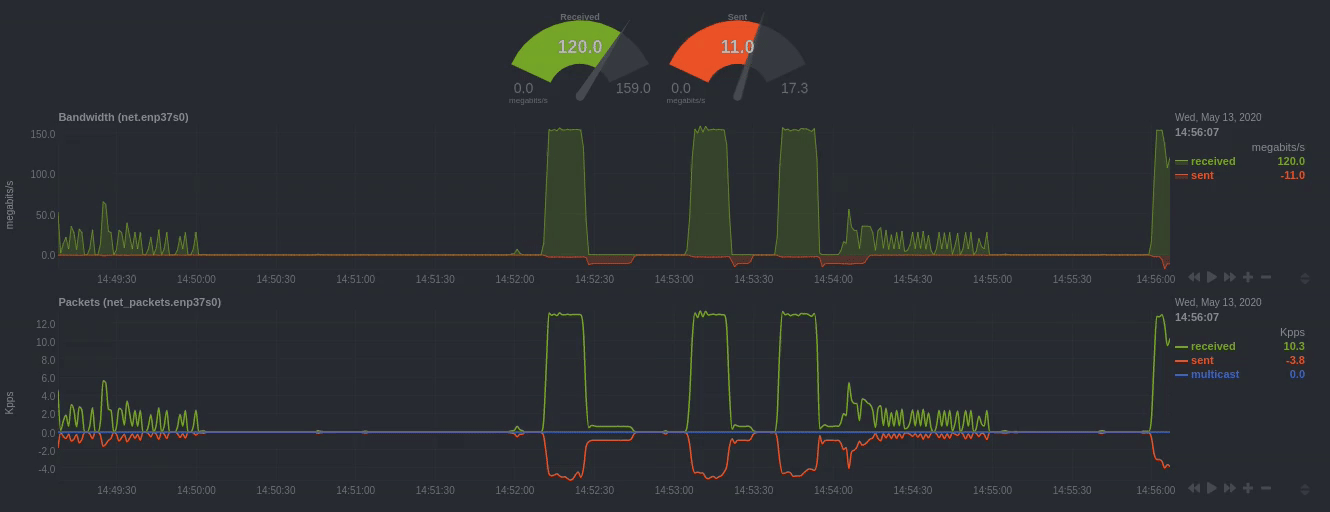
_Netdata charts showing the bandwidth and packets of a network interface. `received` is positive and `sent` is
negative._
### Autoscaled y-axis
Netdata charts automatically zoom vertically, to visualize the variation of each metric within the visible time-frame.

_A zero-based `stacked` chart, automatically switches to an auto-scaled `area` chart when a single dimension is
selected._
### Charts are synchronized
Charts on Netdata dashboards are synchronized to each other. There is no master chart. Any chart can be panned or zoomed
at any time, and all other charts will follow.
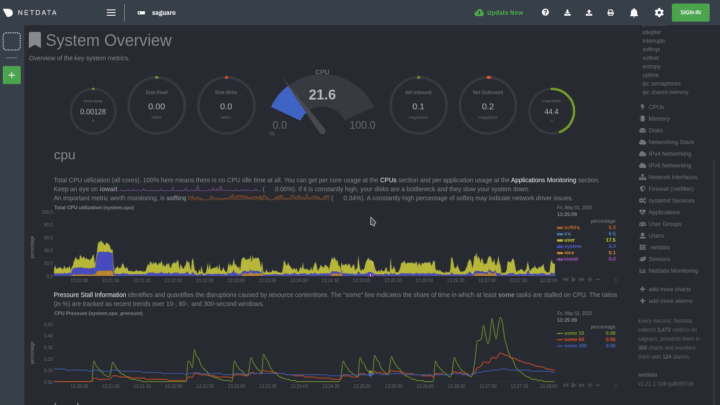
_Charts are panned by dragging them with the mouse. Charts can be zoomed in/out with`SHIFT` + `mouse wheel` while the
mouse pointer is over a chart._
### Highlighted time-frame
To improve visual anomaly detection across charts, the user can highlight a time-frame (by pressing `Alt` + `mouse
selection`) on all charts.
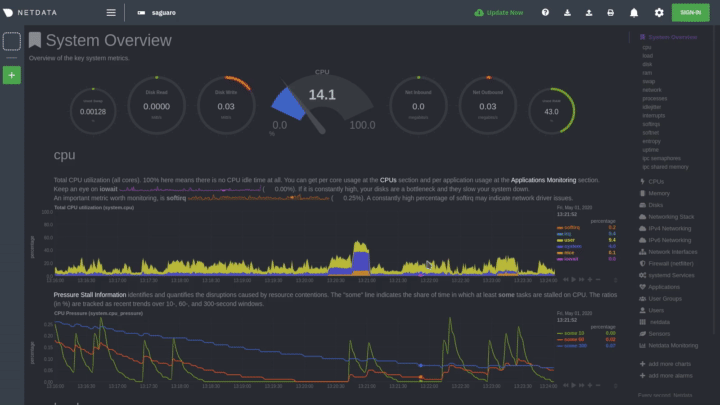
_A highlighted time-frame can be given by pressing
|
